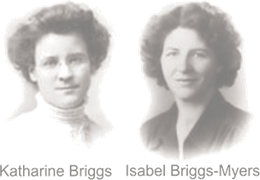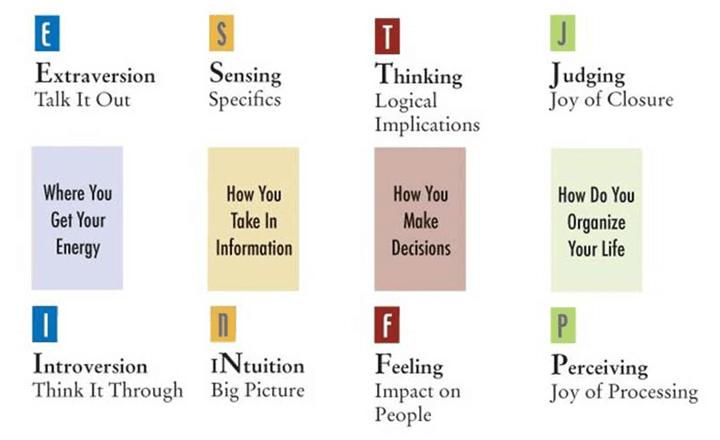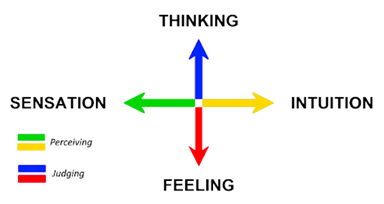The Myers-Briggs Type Indicator


They developed the system to make Jung's work more accessible and valuable in people's everyday lives.
The MBTI is extremely popular but often misunderstood and misused.
We hope to change that misunderstanding so that you can use the MBTI as Katharine and Isabel intended, a Tool to help you understand your Communication and Decision-making Preferences and how you interact with others.
MBTI Personality Types are based on four Cognitive Functions:
- Intuition - abstract concepts and ideas
- Feeling - core values
- Thinking - reasoning
- Sensing - facts and details
The MBTI is about an individual's Cognitive Preferences, not their Cognitive Capabilities.
This is a crucial distinction and is often why many people mistype themselves or think they want to be another type.
Everyone has the same Cognitive Function Capabilities but will use/revert to Preferred Functions most of the time when making decisions, communicating with others, and as a learning style.
For instance, you may let your heart lead you more than your head when making decisions. Nothing is wrong with that, of course. You're using your Feelings to drive your decisions, which is part of your Personality Type.
This is a crucial distinction and is often why many people mistype themselves or think they want to be another type.
Everyone has the same Cognitive Function Capabilities but will use/revert to Preferred Functions most of the time when making decisions, communicating with others, and as a learning style.
For instance, you may let your heart lead you more than your head when making decisions. Nothing is wrong with that, of course. You're using your Feelings to drive your decisions, which is part of your Personality Type.
Only if you want to change and use more Thinking when making decisions will you know what you need to focus and work on because it won't come naturally to you.
You can use your Cognitive Thinking Function more when making decisions. Still, working on it to become more natural would be best.
There is "No one type better than the others."
There is "No one type better than the others."
This is why you need to be honest with yourself. The MBTI is not a competition. It's just a Tool to Help you Understand yourself better.
Extraversion vs. Introversion
Often, people refer to Extraversion and Introversion as their energy source, meaning they are externally energized or motivated by the world outside themself or internally energized or motivated from within themselves.
The Extraversion Trait, as defined by the Big Five Personality Traits model, measures Extraversion on a scale where High Extraversion is what you expect; a person is outgoing and People-Oriented. Whereas a person that scores Low in Extraversions to what we call an Introverted.
However, Extraversion and Introversion have little to do with Sociability or Social Confidence within the context of the MBTI.
The terms Extraverted and Introverted, within the context of the Thinking and Feeling functions, are better thought of as Subjective (Introverted) and Objective (Extraverted).
Within the context of the Sensing function, they are better thought of as Organizing (Introverted) and Gathering (Extraverted).
Within the context of the Intuition function, they are better thought of as Deep Abstract Concepts and Patterns (Introverted) and Broad Concepts and Ideas (Extraverted).
Sensing and Intuition
Consider the situations below and reflect on whether you prefer Sensing or Intuition when considering your preference.
What kind of instructions works well for you?
Do you prefer step-by-step, practical instructions that are clear and accurate (S), or do you like to be given the overall purpose and work it out for yourself (N)?
Imagine you assembling something...
Do you follow the instructions (S) or give it a go (N)?
How do you approach learning something new?
Do you like to try things out and experience, focusing on learning with a practical application (S), or instead, explore how learning fits other ideas and imaginatively (N)?
What information do you need when buying something?
The facts, specifications, and details to see if it will meet your needs (S) or an overview and imagine how the product will work for you, a vision of the future, and how you will use it (N)?
Sensing (S)
Sensing refers to processing data through the five senses.
Characteristics:
- You want to know the facts.
- Look at specifics.
- Collect observations about the world.
Se (Extraverted Sensing)
Extraverted Sensing is the strong awareness of the physical world.
You act on our experiences immediately.
You experience the sights, sounds, and smells of the world around us to your fullest extent.
Characteristics:
- Experiences and notices all the concrete details in the outer world in real-time.
- It is highly attuned to environmental changes and scans for visible reactions and relevant data.
- Adapts and changes with the existing environment and tunes into the moment to maximize the experience and respond.
- It focuses on facts and is extremely realistic.
Si (Introverted Sensing)
Introverted Sensing is the storing of data and then the comparison of that data with other experiences.
For example, when you see a movie that reminds you of another similar movie or when you see someone who reminds you of someone else.
You also use past experiences to learn how to handle similar current situations.
Characteristics:
- Reviews experience to compare and contrast what is to what has been.
- Clarifies and accumulates detailed information and systematically completes projects.
- Preserves vivid sense impressions, remembering exactly how something once was and its impression upon oneself.
- Notices changing patterns and is attentive to alterations and modifications.
- Very practical and detail-oriented.
Intuition (N)
Intuition refers to how people process data looking for meaning and patterns behind the information.
Characteristics:
- Seek out new ideas.
- Ensure things work in theory.
- Use conceptual frameworks.
Ne (Extraverted Intuition)
Extraverted Intuiting involves seeing all possibilities of a subject.
You can juggle many ideas simultaneously and enjoy brainstorming.
Characteristics:
- Sees numerous theoretical possibilities, connections, and relationships between things in the outer world.
- Reads between the lines and explores potential possibilities.
- Has an ever-shifting pattern of ideas and insights triggered by the recent experience.
- Sees everything in the context of how it relates to everything else. Nothing stands alone or is disconnected.
Ni (Introverted Intuition)
This function allows a person to gain a sense of the future by processing data through impressions and meanings.
You discover how the future will be by signs, trends, and patterns.
You will find relationships between many ideas and find ideas similar to those to look for a central idea made up of these smaller ideas.
Characteristics:
- Foresees implications, conceptualizes new ways of seeing things, and gets an image or sense of the future or profound hidden meaning.
- It has a sense of certainty about what will happen. It is energized by transformational visions of how something will develop.
- Receives "flashes" of insight and is tapped into universal symbols.
Thinking and Feeling
Just because someone has a Thinking preference doesn't mean they don't have Feelings! And just because someone has a Feeling preference doesn't mean they don't Think about things!
Thinking and Feeling are Judging functions used primarily when making decisions.
Thinking (T)
Thinking refers to how people make decisions based on reasons.
Introverted Thinking people base their decisions on personal reasons.
Extraverted Thinking people base their decisions on considering objective reasons.
Characteristics:
- Apply logical reasoning
- Use cause-and-effect analysis
- Seek objective truth
- Decide using impersonal criteria
- Focus on tasks
- Provide a critique
Te (Extraverted Thinking)
Extraverted Thinking helps to create order out of chaos.
You organize the environment through charts, graphs, outlines, etc.
It allows you to determine what is necessary and determine the most efficient way to complete an objective.
You love a challenge because it attests to your skills.
You will almost always follow through with a project.
Characteristics:
- Applies logic, order, and efficiency to the outer world.
- Easily notices inefficiency or flaws in a system or plan and is skilled at streamlining processes.
- Expresses thoughts directly and is skilled at critiquing, directing, and organizing.
- Takes decisive action and focuses on objective logic and data to make decisions and create plans.
- Appreciates empirical evidence and dislikes paradoxes.
Ti (Introverted Thinking)
Introverted Thinking finds ways to express an idea that is to the point and concise.
You analyze, categorize, and evaluate to determine whether something fits into the larger framework.
You figure out the specific problem of an idea or concept and then work to fix it.
You often check for inconsistencies worldwide and take things apart to understand how it works.
You use models to see how things should be and look at both sides of issues to determine inconsistencies.
Characteristics:
- Analyzes, categorizes, and organizes internal principles and truths to try to figure out how the world works.
- Notices the fine distinctions between things and creates categories and sub-categories to classify everything accurately and precisely.
- It looks at many sides of an issue to find inconsistencies, always searching for the most extreme form of truth or accuracy.
- Likes to learn for the sake of learning.
Feeling (F)
Feeling refers to how people make decisions based on values.
Introverted Feeling people are more subjective.
You base your decisions on principles and personal values.
Extraverted Feeling people are more objective.
You base your decisions on considering other people's feelings and socially acceptable values.
Characteristics:
- Apply individual values
- Understand others’ viewpoints
- Seek harmony
- Decide according to personal circumstance
- Focus on relationships
- Offer praise
Fe (Extraverted Feeling)
Extraverted Feeling involves considering other people's feelings to a great level.
You often try to help everyone get along. For example, you may disclose your feelings and take on others as your own.
You like to determine what will work best for the group to honor and consider everyone's values and feelings.
You accommodate yourself and others by deciding what is appropriate and acceptable in that setting.
You often use social graces by being polite, considerate, and appropriate.
You often respond to people's expressed or unexpressed wants or desires.
Characteristics:
- Connects and empathizes with others while responding to their values and feelings.
- Monitors the environment for morale or disharmony and tries to create an environment where people feel happy and welcome.
- Discloses personal details to establish rapport. Is usually very aware of social niceties, good manners, and expectations of others.
- "Absorbs" other people's emotions in real-time to sense how they're feeling.
Fi (Introverted Feeling)
Introverted Feeling acts as a filter- it often considers the worth of something based on the truth on which it is based.
You decide whether something is worth standing up for based on its truth and significance.
You often have feelings about a person's essence, which helps you determine if something is fake or genuine.
Introverted Feeling is often expressed through actions and feelings rather than words.
Characteristics:
- Considers what is important and what one's subjective values are.
- Notices inconsistencies between actions and espoused values and, as a result, is very attuned to what is authentic or inauthentic.
- Highly aware of what feels right or wrong to oneself and strives to live by that.
- It continually weighs the situational worth or importance of everything. It expresses values through action rather than words most of the time.
Judging and Perceiving
Judging does not mean you are "judgmental," and Perceiving does not mean you are "perceptive."
Thinking and Feeling are Judging functions, while Sensing and Intuition are Perceiving functions.
You are considered a Judging or Perceiving type of person based on your topmost extraverted function.
The topmost extraverted function may be the first dominant or second auxiliary function; whichever is the top extraverted function determines if you are Judger or Perceiver.
Judging (J)
ENFJ and ESFJ-type people are Judgers because Extraverted Feeling is their dominant function.
INFJ and ISFJ-type people are Judgers because Extraverted Feeling is their auxiliary (second) function but is still their top extraverted function.
ENTJ and ESTJ-type people are Judgers because Extraverted Thinking is their dominant function.
INTJ and ISTJ-type people are Judgers because Extraverted Thinking is their auxiliary (second) function but is still their top extraverted function.
Characteristics:
- Like structure.
- Like to make plans.
- Like to come to a closure.
Perceiving (P)
ESFP and ESTP-type people are Perceivers because Extraverted Sensing is their dominant function.
ISFP and ISTP-type people are Perceivers because Extraverted Sensing is their auxiliary (second) function but is still their top extraverted function.
ENFP and ESTP-type people are Perceivers because Extraverted Intuition is their dominant function.
INFP and INTP-type people are Perceivers because Extraverted Intuition is their auxiliary (second) function but is still their top extraverted function.
Characteristics:
- Are more Process-oriented.
- Like to be spontaneous.
- Remain flexible.
Decoding the Four Letters
The four-letter Myers-Briggs Type indicators are mnemonic codes or dichotomies for the 16 Personality Types. Each of the four letters has a specific meaning, as shown below:


You can imagine Perceiving and Judging like points on a compass.
Where the Judging values of Thinking and Feeling are the North and South poles (the Judging axis), and the Perceiving values of intuition and Sensing (Sensation) are the East and West poles (the Perceiving axis).
Each axis works as opposite pairs, so when one value is Introverted, the other must be Extraverted.
For example, if iNtuition on the Perceiving axis is Introverted, then Sensing must be Extraverted and vice-versa. Similarly, for the Judging pair (the Judging axis), if Thinking is Introverted, then Feeling must be Extraverted and vice-versa. Also, if the Perceiving value is Introverted, Judging must be Extraverted and vice-versa.
The following will show you how to decode the four-letter code.
1. First, let's review the second and third letters:
- The second letter is the Perceiving value, which is either S (Sensing) or N (iNtuition).
- The third letter is the Judging value, which is either T (Thinking) or F (Feeling).

2. The fourth letter is either P if the Perceiving value is Extraverted, otherwise is a J if the Judging value is Extraverted:
- So, in other words, if the second letter is either Ne (Extraverted iNtuition) or Se (Extraverted Sensing), then the fourth letter will be P because the Perceiving axis is Extraverted.
- Otherwise, if the third letter is either Te (Extraverted Thinking) or Fe (Extraverted Feeling), then the fourth letter will be J because the Judging axis is Extraverted.
3. The first letter is either E (Extraversion) or I (Introversion) and indicates which of either the Perceiving of Judging values is the Dominate (top) function:
- This is independent of the last letter that indicates which Perceiving or Judging value is Extravterd. Thus the other will be Introverted (the polar opposite).
- The first letter will indicate which of the Perceinig of Judging values is the top Dominate function.
For example, here are the steps for decoding the INFJ Type:
- Step 1 - The fourth letter J means that the Judging value (the third letter) is Extraverted, meaning the F (Feeling) is Extraverted, thus Fe.
- Step 2 - If the third letter is Extraverted, the second letter must be Introverted (and vice-versa). The second letter (the Perceiving letter) is N (intuition) i, thus Ni.
- Step 3 - The first letter is an I (Introverted), so the Ni must be the Dominate (top) function.
So the INFJ decoded means:
- The Dominate (first/top) function is Introverted intuition (Ni)
- The Auxiliary (second) function is Extraverted Feeling (Fe)
- The Tertiary (third) function is Introverted Thinking (Ti), the opposite pole to Feeling
- And the Inferior (fourth/bottom) function is Extraverted Sensing (Se), the opposite pole to iNutition
Once you know the Perceiving and Judging values by way of the second and third letters
... and which is the Extaverted one by way of the four letters
... and thus, which is the Introverted one by the opposite pole
... plus the first letter that tells you the top function
... you now know the Dominate (top) and Auxiliary (second) functions
The rest of the function stack falls into place via the opposite poles.